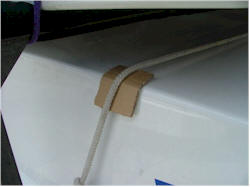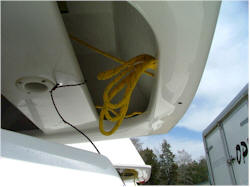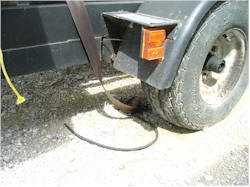| This is a most critical part of
traveling with the Optimist be it one or a dozen boats. Having a boat
get loose can cause an accident and is sure to ruin your weekend. At
least 3 to 4 Optimist fly off someone’s vehicle roof every year. We at
the factory have lost 4. All were on the Interstate Highway at maximum
allowable speed. The boats surprisingly come through such an adventure
in remarkably good condition. McLaughlin has put every road kill
Optimist back on the water and they were structurally sound. But still
precaution is the best prevention.
A little known fact is that most homeowner Insurance policies covers
your Optimist for $1000 to $1200 without any rider or marine policy.
Check your policy under the personnel property section.
Backup Safety System
What ever system you use rooftop or trailer there should be a back
up, fail safe tie down. The back up can be as simple as your painter
going to the front grill and a line from either the air bag hiking
straps or gudgeons to the rear bumper or trailer hitch. If there is a
failure of your main tie down system your back up will allow you time to
pull over and prevent an accident.
Another back up system is once you have a fore and aft strap tight in
place run a line between them and cinch the two together. If the boat
moves in any direction the cinch strap will tighten both the straps
keeping the knots from coming undone. Trust me it works.
When you tie down the boat you can use straps (Thule gives you two)
or line both fore and aft. Try to stay a little away from the bow
because the slope and narrowing tends to make the strap go forward and
loosen. With line what is referred to as a rolling hitch, canoeist hitch
or truckers hitch doubles your power and holds the line tight while you
tie the knot. This knot is strong, secure and allows you to easily untie
your boat when you get to your destination.

 
Polyethylene ski rope stretches especially in rain, avoid it.
You must protect the boat from touching hard abrasive surfaces like
metal. Over a long trip they will wear through the outer gelcoat of your
boat. Canvas covered foam pads are available from most Marine stores.
Carpet, pipe insulation foam, rags and even cardboard work well. Some
line can also be abrasive, especially where it goes over the edge of the
boat. Slipping a small square of cardboard or carpet under the line at
this point will protect your boat bottom cover, which can wear through
in one trip. The small squares can be slipped into place after the lines
are secured.


Be sure the excess tails of your lines are secure. A bowline or boat
strap dropping on the road and getting under a tire can blow out the
tire and damage the boat.


Removing Air Bags on a long trip is recommended unless you have a top
cover. The vibration can wear a hole in the bag and will definitely
shorten its life. A top cover will keep all the lines and parts from
dropping out of the boat including the mast step cup, which tends to
vibrate and back off the adjustment nut. The result is the mast cup and
nut fall off on the highway. We have seen many a family arrive at an
event only to discover they have no mast step. McLaughlin puts a rubber
stopper on the screw end to prevent this but a dab of silicon adhesive
or even a rubber band will do. McLaughlin Boat Works, World
Champion Boatbuilder For Over 40 Years. |